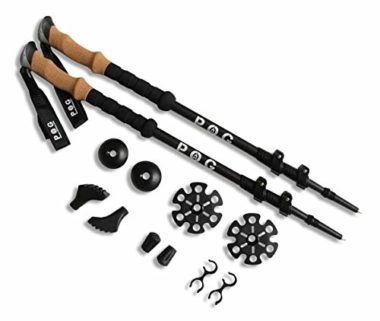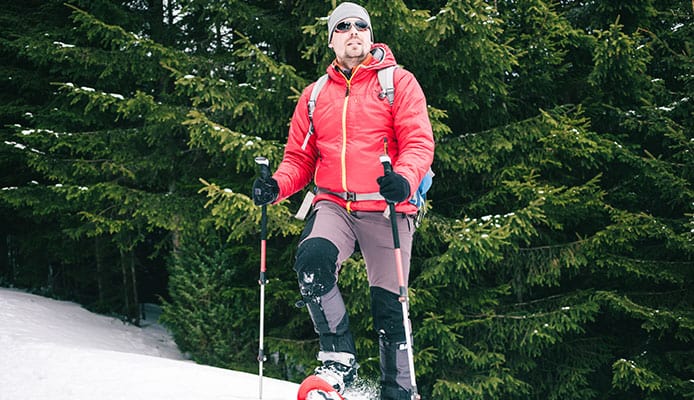
-
1.
-
2.
-
3.
-
4.
-
5.
Hiking and exploring in winter conditions is a fantastic activity that many enjoy, and you don’t need any overly expensive equipment to do it. While reliable snowshoes are the most important thing you need, additional gear like snowshoe trekking poles makes your hike even more comfortable.
Using poles has plenty of benefits – you are more stable and have better traction when you walk, you distribute weight better so there’s less strain on your joints, and your upper body gets some exercise in the process. Finding the best snowshoe poles isn’t difficult but there are some things you need to think about in the process, so be sure to read our buying guide if you want to learn more.
OUR TOP PICK
TrailBuddy Aluminum Quick Adjust

- Stand Out Features - Why We Love It
- Extra-durable shaft material
- Length is easily adjustable
- Moisture-wicking cork grips
- Many color options
- 90-day money-back guarantee
- High quality lock mechanism
Length: 24.5 to 54in
Weight: 9.7oz (per pole)
Shaft: Aluminum 7075
Lock: Lever
Grip: Cork
Accessories: Snow baskets, mud baskets, rubber tips, connectors, carry bag
EDITORS CHOICE
High Trek Lightweight Collapsible

- Stand Out Features - Why We Love It
- Sweat-absorbing EVA foam grips
- Compact and easy to pack
- Tough aluminum build
- 1-year warranty
- High quality locking mechanism
Length: 24 to 55in
Weight: 8.7oz (per pole)
Shaft: Aluminum
Lock: Lever
Grip: EVA foam
Accessories: Snow baskets, rubber tips, connectors
BEST VALUE
Cascade Mountain Tech Aluminum Adjustable

- Stand Out Features - Why We Love It
- Budget-friendly
- Cork and EVA foam grips
- Tungsten carbide tip
- Adjustable wrist strap
- High quality lock mechanism
Length: 26 to 54in
Weight: 10.4oz (per pole)
Shaft: Aluminum
Lock: Lever
Grip: Cork (with EVA foam extension)
Accessories: Snow basket, rubber boots, rubber tips, connectors
NIANYISO Aluminum Collapsible

- Stand Out Features - Why We Love It
- Very small when folded
- Adjustable and padded wrist strap
- Top-level durability
- 45-day money-back guarantee
- High quality locking mechanism
Length: 44 to 53in
Weight: 9.5oz (per pole)
Shaft: Aluminum 7075
Lock: Lever
Grip: EVA foam
Accessories: Snow baskets, mud baskets, rubber tips, rubber boots, carry bag
Sterling Endurance
Sterling Endurance

- Stand Out Features - Why We Love It
- Sold as a single or a pair
- Nice cloth storage bag
- Tungsten carbide tip
- 1-year warranty
- High quality lock mechanism
Length: 44 to 54in
Weight: 10.8oz (per pole)
Shaft: Aluminum 7075
Lock: Lever
Grip: EVA foam (with extension)
Accessories: Snow baskets, rubber tips, carry bag
Paria Outdoor Products Tri-Fold Carbon Cork

- Stand Out Features - Why We Love It
- Folding trekking pole design
- Comes in two sizes (both adjustable)
- Ergonomic cork grips
- Lifetime warranty
Length: 39 to 47in and 45 to 53in
Weight: 9oz (per pole)
Shaft: Carbon fiber (with aluminum reinforcement)
Lock: Lever
Grip: Cork
Accessories: Snow baskets, rubber tips, carry bag
CAMMPO Ultra Strong Collapsible

- Stand Out Features - Why We Love It
- Lightweight Duralumin shaft
- Many different tips and baskets included
- Ergonomic anti-slip cork grip
- Quick and easy adjustment
Length: 25 to 54in
Weight: 9.9oz (per pole)
Shaft: Aluminum 7075
Lock: Lever
Grip: Cork
Accessories: Snow baskets, mud baskets, boot tips, rubber tips, connectors, carry bag
G2 GO2GETHER Auto-Adjustable

- Stand Out Features - Why We Love It
- Auto-adjustable strap
- Plastic handle
- Affordable
- 1-year warranty
Length: 25 to 53in
Weight: 9.9oz (per pole)
Shaft: Aluminum 6061
Lock: Lever
Grip: Plastic
Accessories: Snow baskets, rubber tips, carry bag
Premier Outdoor Gear Collapsible

- Stand Out Features - Why We Love It
- Carbon fiber shaft
- Breathable adjustable straps
- Money-back guarantee
- Plenty of accessories for different terrains
Length: 24 to 54in
Weight: 7.6oz (per pole)
Shaft: Carbon fiber
Lock: Lever
Grip: Cork (with EVA foam extension)
Accessories: Snow baskets, mud baskets, rubber tips, rubber feet, carry bag
Titan Outfitter Carbon Fiber

- Stand Out Features - Why We Love It
- 3M Fly-Tech carbon fiber
- Compact and easy to pack
- Tungsten carbide tip
- Carry case with bottle holder
- High quality locking mechanism
Length: 24 to 54in
Weight: 7.6oz (per pole)
Shaft: Carbon fiber
Lock: Lever
Grip: Cork (with EVA foam extension)
Accessories: Snow baskets, mud baskets, rubber tips, rubber feet, carry bag with bottle holder
How To Choose The Best Snowshoe Poles – Buying Guide
A good pair of snowshoe poles is going to make your step safer and more secure, whether you’re walking uphill, downhill, or on uneven terrain. Adding them to your gear improves your experience when snowshoe hiking because they help spread the weight evenly and reduce fatigue. Take a quick look at what you need to consider when buying them.
Length and Adjustability
Your poles must be long enough for proper use – it’s said that your elbow should be at a 90° angle when you grab the handle, while the tip is touching the ground. You should get poles that can be adjusted to that length, but that also allows you to easily change the length on different terrain (shorter poles for uphill and deep snow, longer poles for downhill).
Many shorter people have trouble finding the right poles, so we also featured several poles for short beginners, so that anyone can enjoy themselves and learn how to snowshoe.
Weight
Pole weight is an important factor for some people because heavier poles can cause arm fatigue faster. Luckily, most materials used nowadays are fairly light, so this shouldn’t be a deciding factor. Ultra-light poles are often less durable, so be careful when choosing.
Lock Mechanism
Adjustable poles are locked at a certain length with either a lever (flip) lock, or a twist lock. Twist locking means turning the shaft in one direction to unlock and adjust the length, then turn in the other to lock. It’s often unreliable because it unlocks itself. Top-rated snowshoeing poles have flip-locks that are more secure and much easier to use.
Shaft Material
Two of the most popular materials used are aluminum alloy and carbon fiber. Aluminum is stronger and more durable, but aluminum poles are a few ounces heavier. Carbon fiber is lighter and reduces strain on your arms, but it can get damaged or broken more easily. Some manufacturers even combine these two materials to give the best balance of strength and weight.
You might also like: Boots For Snowshoeing
Grip
The grip on your trekking pole is important for stability and comfort. The best snowshoeing poles have handles (grips) made of either cork or EVA foam (many offer a combination of the two). These materials wick sweat, don’t slip, and don’t retain odors. Avoid plastic and rubber because they are uncomfortable. In addition to handles, all poles come with wrist straps for better support. Make sure they are adjustable and padded, so they don’t chafe your skin.
Design
Snowshoeing poles offer 2 design solutions – telescoping and foldable. Telescoping poles have 2 or 3 pieces that slide into each other while folding poles have pieces that are detached from each other and then packed. Which type you decide to get isn’t significant, but the length of the folded trekking pole is. The best snowshoeing poles are compact when packed and can fit in your backpack.
Interchangeable Baskets and Tips
The snow (powder) basket is the thing that makes these poles usable on the snow. These are wide discs that compress the snow and prevent the pole tip from getting buried deep, allowing you to walk with good support. All products in our poles reviews come with snow baskets. They also have other accessories like mud baskets, rubber tips, or rubber boots, allowing you to use them for year-round hiking.
FAQs
Q: What Are Snowshoe Trekking Poles?
Q: Are Snowshoe Trekking Poles Absolutely Necessary?
Q: What Is The Difference Between Snowshoeing And Trekking Poles?
Globo Surf Overview
As you’ve had the chance to see, a pair of poles makes a fantastic addition to your snowshoeing equipment. They offer plenty of benefits, and won’t set your budget back too much. If you’ve already selected the snowshoes you like, as well as a pair of boots for snowshoeing, think about snowshoeing poles. Numerous hikers can’t even imagine snowshoeing without them, so give them a shot and start enjoying hikes on the snow even more.



